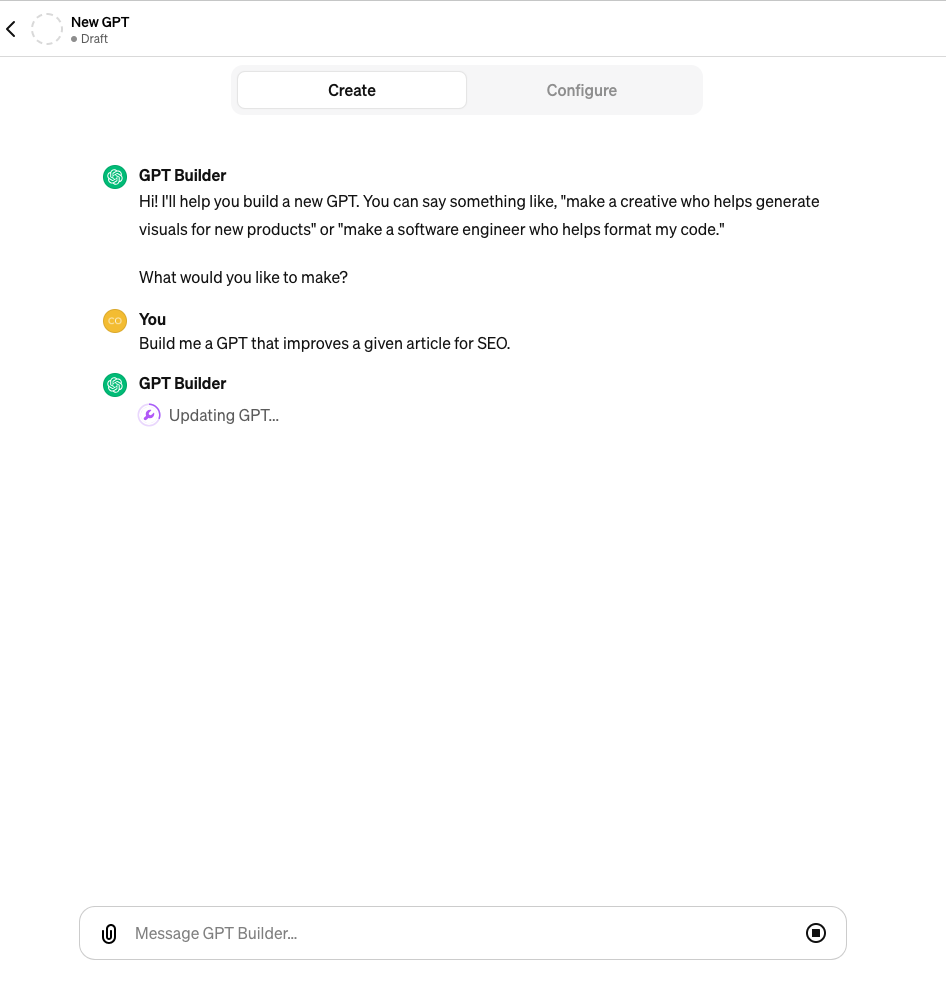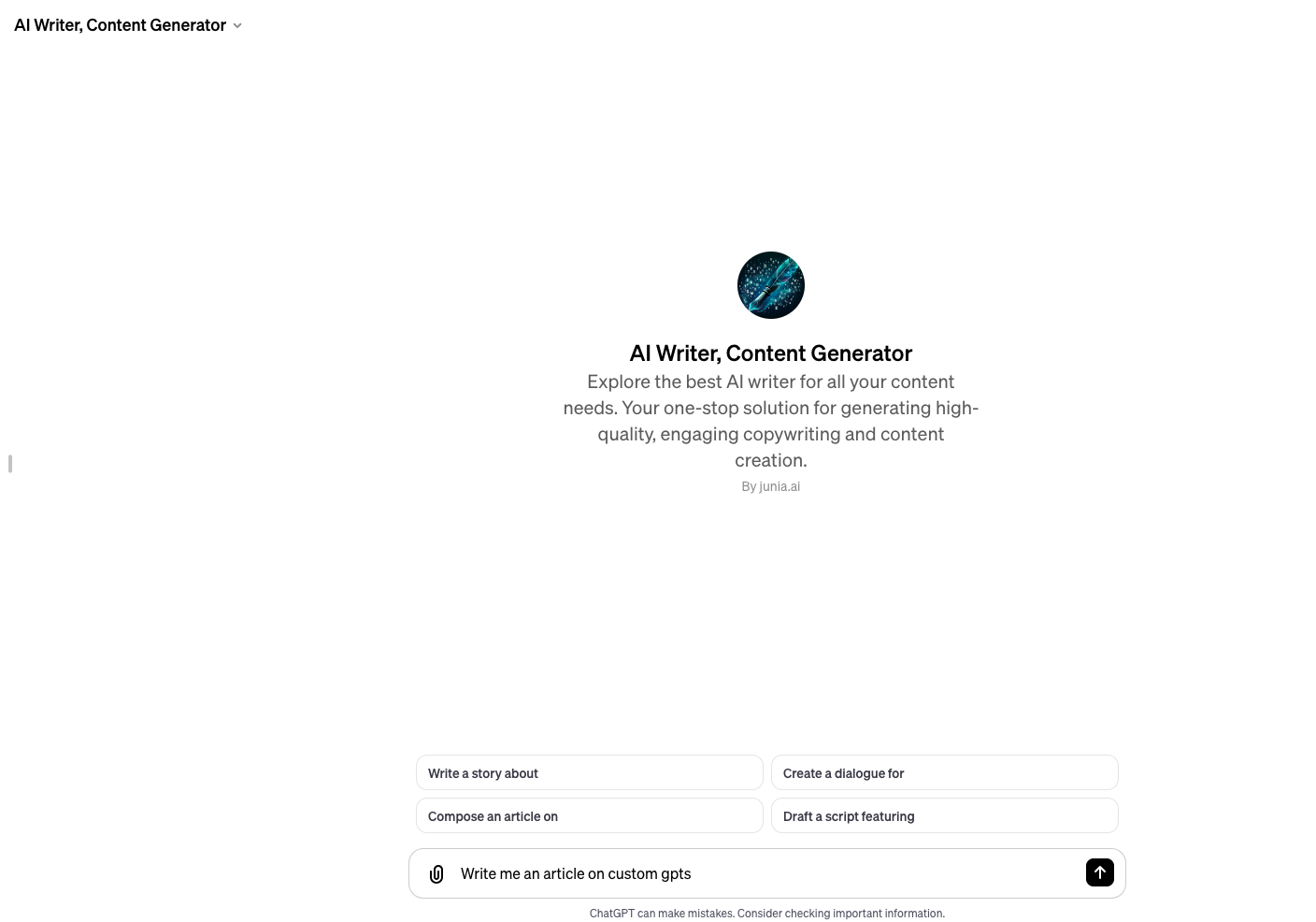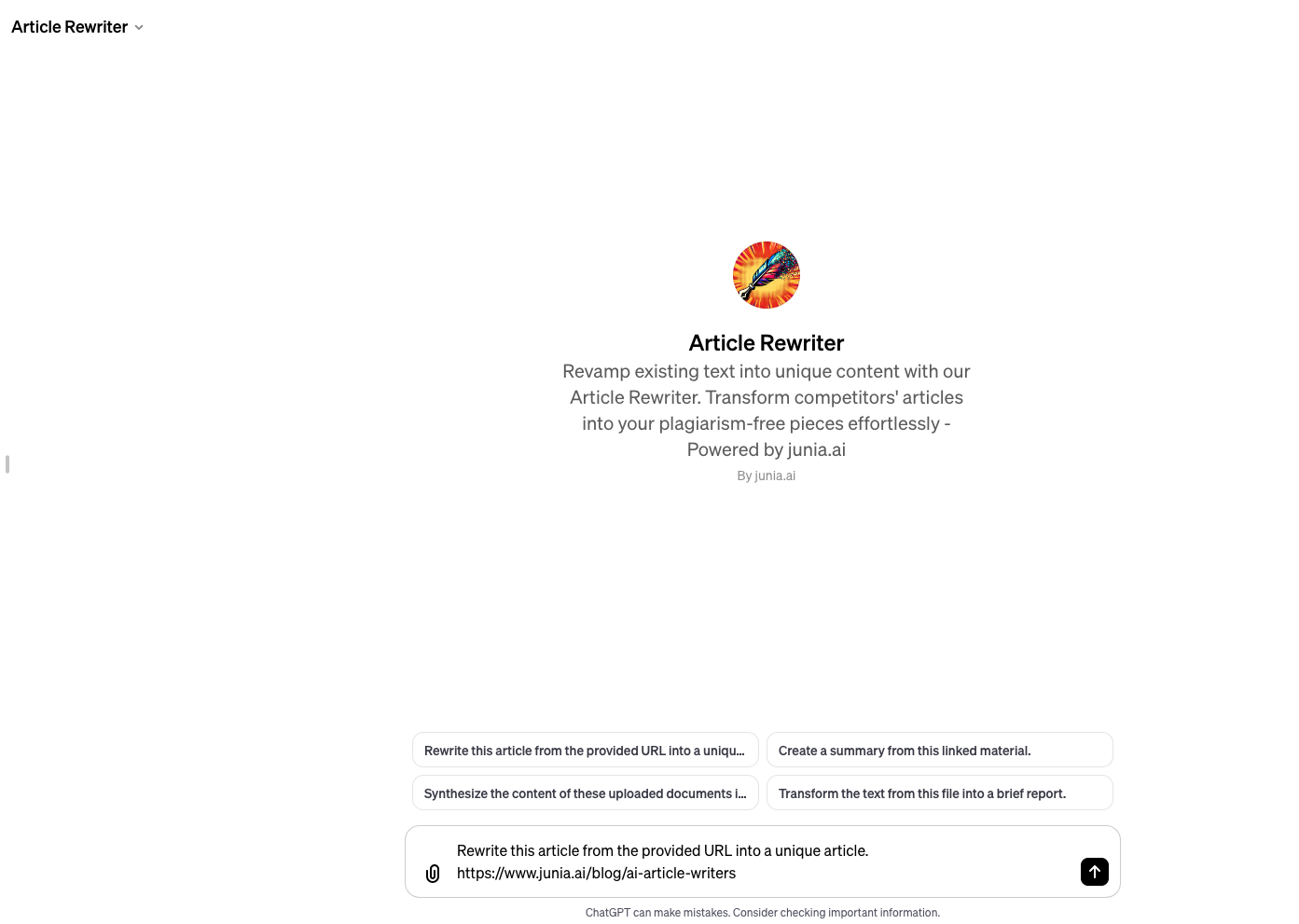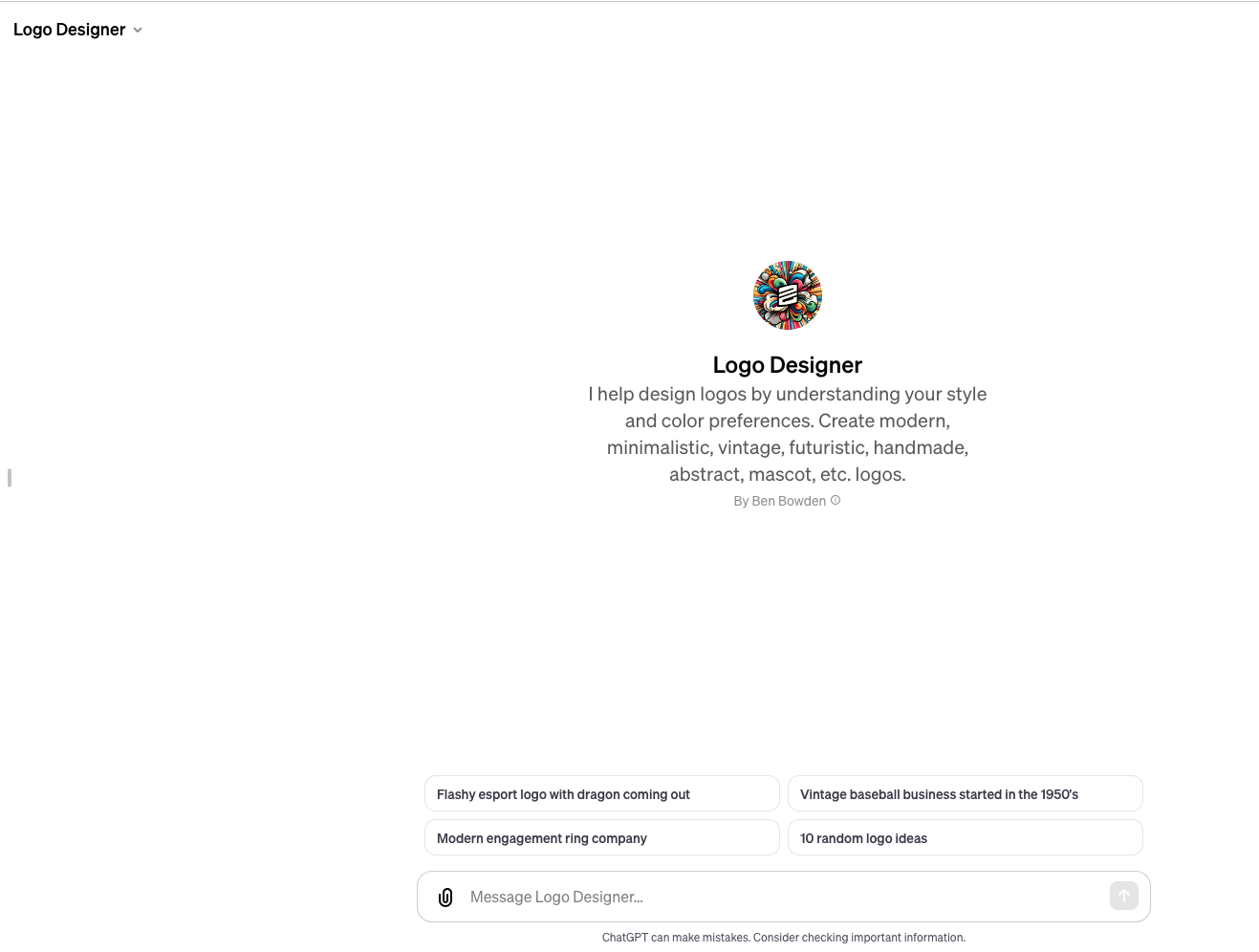
Introduction
Generative Pre-trained Transformers (GPTs) have made some huge steps in Artificial Intelligence (AI), and honestly, they’re changing how we use tech every day. These smart AI models can understand context, write text that sounds like a real person, and keep learning from how people use them. That’s why they’re super useful in all kinds of areas.
GPTs, also called custom ChatGPTs, are like special versions of ChatGPT. They’re made mainly for conversations, so they can copy the way humans chat and give really helpful answers. Because of that, they work great for stuff like customer service or tech support. Interestingly, these models can also be utilized as a kind of friendly companion when you need to talk to something. If you're exploring options for such AI companions, you might want to check out some best alternatives to ChatGPT for companion bots, which provide unique, engaging AI friends for conversation and emotional support.
One really cool thing about these technologies that people kind of forget about is Customization. Like, seriously, you can actually create your own AI models now without needing to know how to code at all.
In this article, we'll talk about GPTs (Custom ChatGPTs) and how you can use the new tools from OpenAI to build your own unique models. Whether you're an AI fan just wanting to try out some new ideas, or a business owner wanting to make customer service better, this guide will give you some useful tips about GPTs.
So yeah, let's start exploring this whole exciting world and see what we can actually do with customized AI using GPTs!
While you're here, you might want to check out our detailed review of the best GPTs available. We've rated each tool based on features, ease of use, and value for money. That way, it’s easier for you to pick the GPT that fits your needs best. Let's explore the endless possibilities these amazing AI helpers offer.
Understanding GPT Builder

When you start learning about Generative Pre-training Transformers (GPTs), you’ll pretty quickly run into something called GPT Builder. So, like, in simple terms, GPT Builder is just a tool that lets you make your own ChatGPT models without needing to know how to code at all. You don’t have to be super technical or anything. It basically makes AI easier to use for pretty much everyone, no matter what kind of technical background they have, or even if they don’t really have one.
GPT Builder: A Tool to Create Custom ChatGPTs Without Coding
Imagine if you could just make your own AI model that does the exact stuff you need it to do. Pretty cool, right? That’s basically what GPT Builder lets you do. It’s a pretty easy-to-use tool that helps you build custom ChatGPTs and you can control their personality, skills, and settings all in one place.
So yeah, how does it actually work? Let’s take a look and find out.
How to Use GPT Builder: A Simple Guide
Here’s how you can create your own custom ChatGPT using GPT Builder, it’s actually not that hard:
- Log in to ChatGPT: First, go to https://chat.openai.com/create and log in.
- Decide Your GPT’s Role: Think for a minute about what you want your GPT to do. Like, is it going to be a personal finance helper, an SEO expert, or maybe a project manager kind of thing? This part really affects how you build it.
- Set the Limits: After you know its role, decide what tasks it should actually handle and what kind of conversations it will have with people. What it should do and also what it shouldn’t do.
- Pick Its Skills: Now choose the skills your GPT needs. For example, an SEO expert GPT might look at website traffic and give useful SEO tips and stuff like that.
- Test and Improve: Try using your GPT yourself and maybe let others test it too. Then tweak it, like make changes based on feedback so it works better and feels more helpful over time.
- Launch and Connect: When you’re happy with it, set up your GPT and connect it to whatever platform or system you want to use it with.
The GPT Builder is pretty simple to use and walks you through each step, so you really don’t need any coding skills at all.
Customizing Your GPT: Configuration Options

The GPT Builder provides a versatile platform to customize your AI model in numerous ways. You can change its name, modify the avatar, add personal knowledge sources, and much more. If you're looking to expand its capabilities, you have the option to enable extra features like web browsing or image creation. Additionally, you can set the tone for how it initiates conversations, making it feel more aligned with your personal style.
It's important to remember that building a custom GPT is a step-by-step process. It's not about getting everything perfect on the first attempt. You can revisit previous configurations, make adjustments, redo certain aspects, and continue refining until your model operates exactly as you envision it. This is where tools like Junia AI’s persona instructions generator come in handy, allowing for tailored, consistent, and engaging chatbot interactions. So go ahead and experiment with the customization options extensively!
Making Money and Sharing Your GPTs through the GPT Store (Coming Soon)
After you finish creating and customizing your own chatbot with GPT Builder, you’ll probably want to share it with more people. Like not just your friends. That’s where the GPT Store comes in and helps a lot.
AI is changing how we work and live by taking over routine tasks, helping with better decisions, and kind of sparking new creativity too. As more businesses start using AI, a few trends are really shaping the workplace right now:
- More Automation: Companies are using AI tools to handle boring admin tasks so employees can focus on more important work, the stuff that actually matters.
- Data-Based Decisions: AI helps analyze big data really fast, so companies can make smarter choices quicker instead of guessing or waiting forever.
- Personalized Employee Support: AI customizes training and support for each person based on their needs and performance, so everyone isn’t stuck with the same generic stuff.
- Better Teamwork Tools: AI-powered platforms improve communication and project management, especially for remote teams that are all over the place.
- Improved Customer Service: Chatbots and virtual assistants give quick help and more personalized experiences for customers, which honestly people expect now.
All of this boosts productivity by making work smoother and more organized and also kind of pushes teams to be more creative and flexible too.
What is the GPT Store?
The GPT Store is not available yet, but it’s supposed to be a pretty powerful marketplace for AI models. Basically, it will be an online platform where trusted creators can:
- Share their AI models so other people can try them and use them
- Make money depending on how often their models are used
- Get noticed and recognized through leaderboards and featured GPTs, kind of like being highlighted for doing well
Making Money with Your Custom Chatbot
The GPT Store lets you make money in a couple of different ways, which is honestly pretty cool:
- Get Paid When People Use Your Chatbot: You earn a share of the money that comes in whenever people use your AI model. So basically, the more people who use it, and the more often they use it, the more you end up making.
- Possible Future Subscriptions: In the future, there might be options for individual subscription plans. That would mean creators could get regular, kind of steady income from users who want ongoing access to their chatbot and keep coming back to it.
Reaching a Large Audience with Custom GPTs
One of the biggest perks of listing your chatbot in the GPT Store is that you can connect with a ton of users and developers who care about AI content creation. When you make your chatbot easy to find on this platform, you can:
- Reach users from different industries
- Attract developers who want to use your chatbot on various platforms
- Get feedback from users to improve your AI model
Just remember, building an AI model with GPT Builder is really only the first step. The real journey kind of starts after that, when you share your model on the GPT Store. That’s when you open up real chances to earn money, get feedback, and keep improving it over time.
Real-Life Uses of Custom GPTs
So, let’s talk about how custom GPTs like ChatGPT, Claude, and Gemini actually show up in normal, everyday life. It’s not just some tech buzzword thing. People use them for writing content, making logo ideas, and honestly a bunch of other random stuff too. These tools really show how flexible GPT technology is at work. Anyway, here are some examples:
1. Blog Content Generator GPT

A blog content generator powered by a custom GPT can seriously make writing your blog posts way easier. Especially now with newer tools like ChatGPT 5 and Claude 4 Sonnet, it kind of feels like cheating a bit, in a good way. You just give it a topic or a keyword, and the AI comes back with a full article outline for you.
It usually includes suggested headings, sub-headings, and the main points for each part, so you’re not staring at a blank page wondering where to start.
Example: Input: "The benefits of yoga"
Output:
Using this tool can save you a lot of time planning your posts, so you can spend more energy on actually writing great content instead of getting stuck on the structure part.
2. Article Rewriter
 An Article Rewriter is basically a really handy tool for writers, marketers, and SEO experts. It takes any article you give it and rewrites it in a fresh and clearer way, but still keeps the same main meaning and facts so nothing important gets lost.
An Article Rewriter is basically a really handy tool for writers, marketers, and SEO experts. It takes any article you give it and rewrites it in a fresh and clearer way, but still keeps the same main meaning and facts so nothing important gets lost.
- Example:
- Input: "AI is transforming multiple sectors including healthcare, finance, and education."
- Output: "Many industries like healthcare, finance, and education are being changed a lot by AI progress."
3. LogoGPT

LogoGPT is a pretty cool tool that uses AI to turn simple text instructions into unique logo designs. You just tell it what you want and it kind of figures out the look for you.
- Example:
- Input: "Create a logo for 'Cafe Mocha' with a coffee mug and a vintage style."
- Output: [AI Generated Logo Image]
This tool can be super useful for brand creators and graphic designers who need to come up with new logo ideas fast. Instead of starting from scratch every time, they can use LogoGPT to get quick concepts and then tweak them however they like.
4. Relationship Guide GPT

A Relationship Guide GPT is basically like a helpful friend that gives tips and advice about different parts of relationships. It can help with communication, handling fights, solving conflicts, and honestly a bunch of other stuff too.
- Example:
- Input: "How to improve communication in a long-distance relationship?"
- Output:
- "1. Schedule Regular Video Calls: ... 2. Share Daily Updates: ... 3. Send Surprise Gifts: ..."
So yeah, this kind of shows how custom GPTs can be built to fit really different needs in lots of fields. They do more than just save time. They give people and businesses tools to make what they do better, and also kind of push them to try new ideas and be more creative.
Custom GPT for Parasite SEO
When a custom GPT is made public, OpenAI gives it its own unique URL. So yeah, this link can be shared with other people, which makes the AI tool really easy to access and use. One pretty interesting benefit of this is connected to Parasite SEO, which is a strategy where you use popular websites with strong authority to help boost visibility. Kind of like, you borrow their power to get more attention.
What is Parasite SEO?
Parasite SEO is a technique where you post your content on a website that already has really strong authority. So basically, instead of starting from zero, you kind of “borrow” the power of that site. This helps your content rank better in search engines because it gets a boost from the site's trust and reputation.
Note: Parasite SEO is a valid method, but it's important to use it ethically and avoid any misuse. So yeah, don't be shady with it.
Why OpenAI's Strong Website Authority Matters
OpenAI has really strong website authority, which basically means it shows up high in search engines a lot. So yeah, this makes it a pretty great place to use parasite SEO strategies and kind of ride that wave a bit.
- Better Search Rankings: Because of OpenAI’s strong authority, content that’s linked to your custom GPT can end up ranking higher in search results, sometimes way higher than it would on your own site.
- Linking Back to Your Site: You can put links in your GPT content on OpenAI that send users back to your own websites, which can help boost your site’s traffic and visibility over time, maybe more than you’d expect.
Using Custom GPTs for Parasite SEO
Here’s how you can really get the most out of your custom GPT for parasite SEO, without overcomplicating things:
1. Build a Quality GPT
Your GPT isn’t just some random AI tool, it kind of represents your brand and what you’re about. So if you want people to actually like it and stick around, you’ll want to focus on making it reliable and easy to use. Stuff that doesn’t confuse people. Here’s what to think about:
- Stay Relevant: Make sure your GPT actually fits your industry or niche. It should give helpful information that makes sense for your field, not just generic answers.
- Be Knowledgeable: Load it up with plenty of useful info so it feels trustworthy and valuable. People should feel like they’re getting real help, not fluff.
- Make It User-Friendly: Design it so it’s simple and honestly kind of fun to use. If it’s smooth and not annoying, people are more likely to come back and maybe even share it with others.
2. Include Brand Mentions in Content
Another solid way to boost visibility is to have your GPT mention your brand in a natural way while it’s answering questions. Not in a spammy way. Just casual and helpful. Keep these in mind:
- Keep It Natural: Brand mentions should fit into the content like normal conversation. If it feels forced or robotic, people will notice and tune it out.
- Add Value: Whenever your brand is mentioned, connect it to something useful like a tip, insight, or solution. That way readers start to see your brand as something that actually helps them.
If you follow these steps, you’re not just tapping into OpenAI’s strong online presence, you’re also giving real value to users. That combo works really well for parasite SEO.
Using custom GPTs together with parasite SEO can boost your online visibility and website traffic, while also giving your audience some pretty cool and innovative AI tools to use.
Privacy and Safety in GPTs
When you’re using GPTs, you might kind of stop and wonder how your privacy and safety are actually being protected. It’s really important to keep your personal information secure, you know, and to make sure that whatever you’re doing with GPTs stays safe. So yeah, let’s take a closer look at how GPTs handle privacy and safety.
Protecting Your Privacy with GPTs
When you use a GPT, you might sometimes share private or sensitive stuff without even really thinking about it. And yeah, that information is important, so it needs to stay safe. OpenAI really does care about privacy and has some steps in place to help protect your data.
- If you create a GPT, you cannot see the private chats that users have with it.
- So basically, any personal details people share are kept away from others and not just out there for anyone.
Making GPTs Safer
Safety is super important when using AI models like GPTs, honestly. OpenAI has set up different ways to try and reduce risks and help keep users safe while they use them.
- There are automatic systems that check the content GPTs produce, kind of like a constant review in the background.
- These systems can spot and flag inappropriate content or actions that break OpenAI's rules, even if you don’t notice it right away.
- If a problem is found, the right steps are taken to fix it, or at least try to solve what went wrong.
How Policies Are Enforced
OpenAI uses automatic systems to help keep users safe when they interact with GPTs. It’s kind of a whole process. Here's how it works:
- Content Monitoring: The system keeps an eye on all the content that the GPT creates. Basically, it’s always watching what gets generated.
- Policy Violation Detection: It looks for any content that breaks OpenAI's rules, and yeah, it tries to catch that stuff as soon as it shows up.
- Immediate Action: When a problem is found, quick steps are taken to fix it, or remove it, so things don’t get worse.
This all helps make sure that using GPTs is safe and that everything stays within OpenAI’s guidelines.
By focusing on privacy and safety, OpenAI offers a platform where users can interact with GPTs without worrying so much about their personal information being misused or running into harmful content, which is honestly pretty important.
The Future of AI Customization with GPTs
Artificial intelligence (AI) is always changing, like, all the time, and improving faster than we can really keep up with. A big part of this progress comes from Generative Pretrained Transformers, or GPTs. As we look ahead, the importance and potential of GPT technology in customizing AI is starting to become a lot clearer, little by little, and it’s honestly kind of exciting.
Better Access for Everyone
One really important thing here is accessibility. Tools like GPT Builder and GPT Editor let people make their own AI models without needing to know how to code at all, which is honestly pretty cool. So yeah, AI isn’t just for big tech companies or experts anymore, it’s kind of open to everyone now.
- Business owners can use custom AI to make their work smoother and improve how things get done.
- Teachers can use AI to help make learning better and maybe a bit more fun too.
- Artists can use AI for creative projects and new ideas they might not think of on their own.
- People from all kinds of backgrounds can use AI to work on really tough problems.
By making it easier to create and change GPT models, these tools can help bring AI into a lot of different industries faster, and honestly, into everyday life too.
Unmatched Flexibility
GPTs are super flexible, like surprisingly flexible. They can learn from a ton of information and then create text that sounds pretty close to what a real person might write, based on whatever instructions you give them. So yeah, GPTs can be used for all kinds of tasks, such as:
- Writing emails
- Creating articles
- Making creative content
- Having human-like conversations
But GPTs don’t just generate text and stop there. They’re getting better at handling other types of data too, and doing more complex stuff, like creating images and really analyzing data in a deep way. This kind of flexibility is probably going to change how we use artificial intelligence in general.
The Growth of Custom AI Marketplaces
Another pretty exciting thing happening right now is the rise of platforms like the GPT Store. So basically, these platforms let creators put up and sell their own unique GPT models, and yeah, that means there could end up being this whole huge marketplace for all kinds of specialized AI tools.
The Journey Ahead
As we move into this new era, it’s pretty clear that GPT technology is going to be a huge part of how the future of AI customization works. There’s still a lot we don’t fully understand yet about what it can really do, honestly. And as we keep exploring and testing and creating new stuff and then improving these tools again and again, it kind of feels like we’re only just beginning this journey into the future of AI customization with GPTs. It’s probably going to be a really exciting ride.
Conclusion
GPTs have huge and growing potential, and honestly, they’re just getting started. They’re a big step forward for AI, changing how we use technology and making it way easier to personalize AI tools for what you actually want.
These powerful models are available to everyone now, even if you don’t know how to code at all. Tools like GPT Builder and GPT Editor make creating custom ChatGPT models pretty simple and, like, not as scary as it sounds.
Here’s how you can use these models:
- Create AI models that fit your needs: Whether it’s a chatbot for your website, a personal virtual assistant, or something small you just want to test, you can build models that work just for you.
- Try out different features and functions: GPT Builder and GPT Editor let you adjust how the model behaves and responds, so you can experiment a lot and explore different options till it feels right.
- Make money by sharing your models on the GPT Store: If you create a helpful or creative model, you can share it with others on the GPT Store and maybe earn income from it too.
OpenAI’s safety and privacy measures help keep your interactions secure and private, which is pretty important. GPTs are already useful in a bunch of real-world tasks, like creating blog outlines, rewriting articles, and honestly a lot more.
You’re in control of your own tech journey here, with almost endless possibilities ahead. You can step into this new age of AI customization and shape your tools to actually fit your vision, not just use whatever’s handed to you.
With GPTs, creation is ongoing, it just keeps growing and changing. As we move forward, we can keep exploring, keep innovating a bit, and keep reshaping how we work with technology together.
